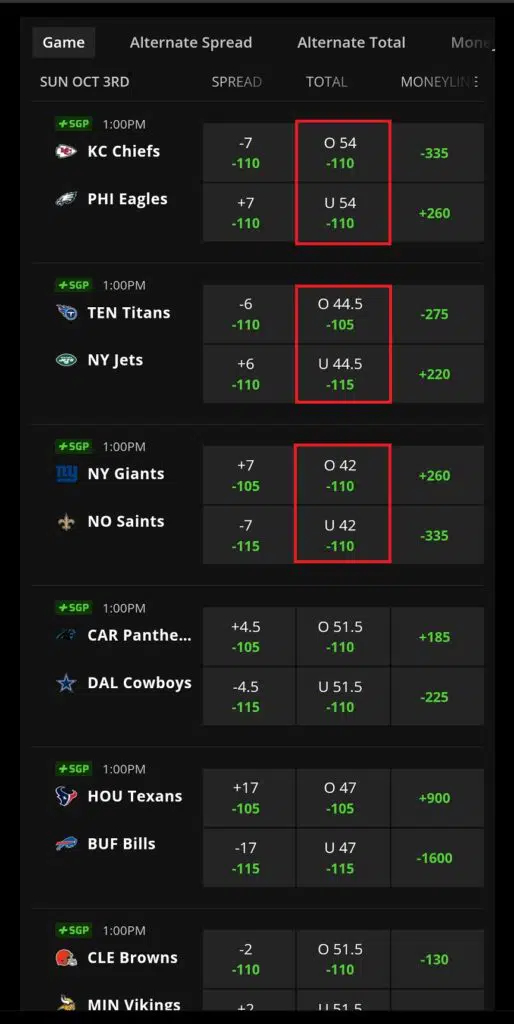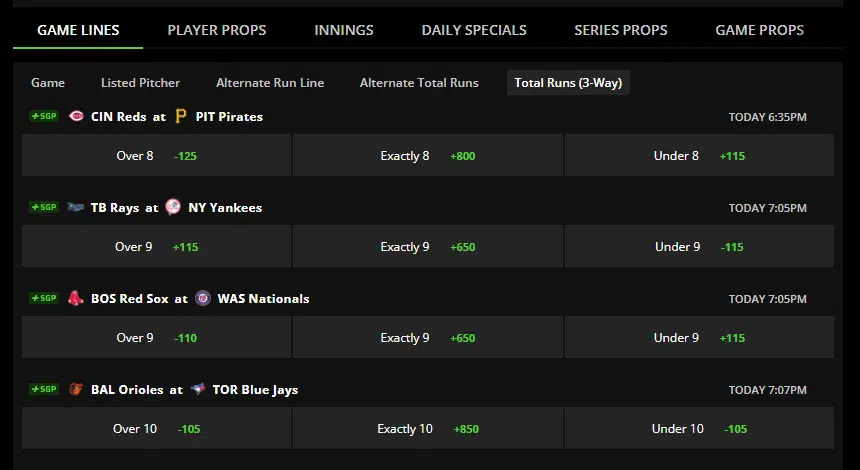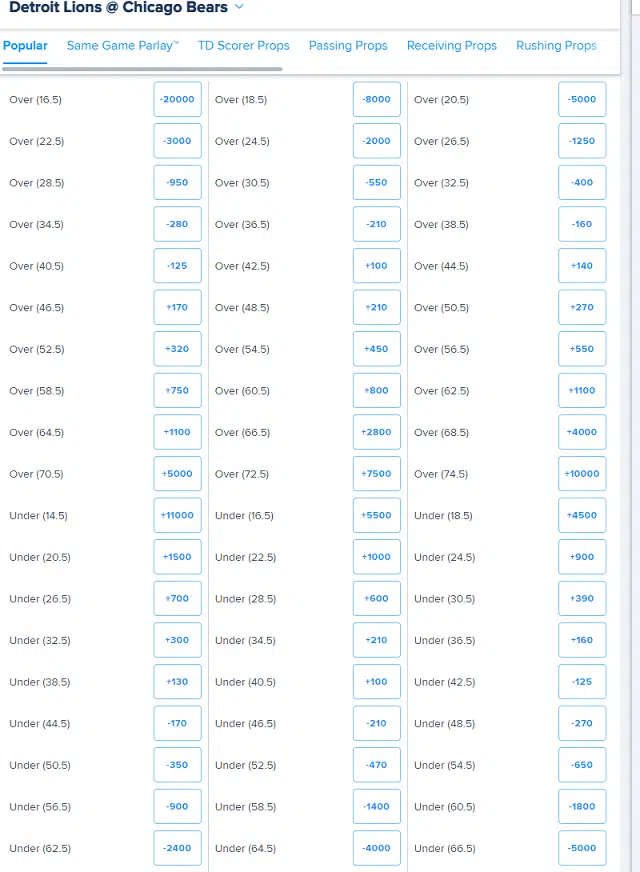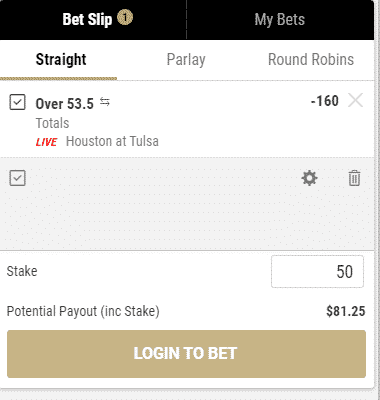Point totals, also known as over/under bets, allow bettors to predict whether the combined scores of two teams will be over or under the line published by the book. For example, a sportsbook may set the total for an upcoming game at 50.5 points, and bettors try to predict whether the actual score will be over or under the posted line.
On this page, BettingUSA explains how over/under bets work, where to find them, and how to make the most out of totals bets.
Totals Betting Sites
 Play $5, Get $50 in LineupsPrizePicks Promo Code: BUSA
$50 provided as promo funds, only for use on PrizePicks. Promo funds provided under this promotion must be played within 90 days of receipt or shall become null and void at PrizePicks’ discretion. Promo ends 12/31/25. Void where prohibited. If you or someone you know has a gaming problem, get help. Crisis services and responsible gaming counseling can be accessed by calling 1-800-426-2537 or online at www.ncpgambling.org. 18+ in most eligible jurisdictions, but other age and eligibility restrictions may apply. Valid only in jurisdictions where PrizePicks operates. See prizepicks.com/terms for full PrizePicks terms of service.
Play $5, Get $50 in LineupsPrizePicks Promo Code: BUSA
$50 provided as promo funds, only for use on PrizePicks. Promo funds provided under this promotion must be played within 90 days of receipt or shall become null and void at PrizePicks’ discretion. Promo ends 12/31/25. Void where prohibited. If you or someone you know has a gaming problem, get help. Crisis services and responsible gaming counseling can be accessed by calling 1-800-426-2537 or online at www.ncpgambling.org. 18+ in most eligible jurisdictions, but other age and eligibility restrictions may apply. Valid only in jurisdictions where PrizePicks operates. See prizepicks.com/terms for full PrizePicks terms of service.
*The options available in your state are fantasy pick’em apps and social sportsbooks, not technically sports betting.
One of the biggest appeals of totals betting is that it can create excitement where it typically wouldn’t exist.
Consider an NFL game where the home team jumps out to a 35-7 lead in the third quarter. Normally, there would be little reason to continue watching. Barring a miracle, everyone has a pretty good idea of who is going to win.
However, point totals can turn mundane blowouts into highly compelling games. Fans with active totals in play may find themselves on the edges of their seats with minutes remaining even if the underlying game isn’t close.
Over/Under Bets Explained
An over/under is a bet on the total number of points, goals, or runs that both teams will score in a game. The most popular variant revolves around the final score.
For example, imagine the Denver Broncos are playing the Atlanta Falcons this Sunday, and oddsmakers have set the total at 47.5.
Bettors have two options to bet the total in this game. First, they can take the over, denoted at o47.5 or OV 47.5, and will win if the final combined score totals 48 or more points. Or, they can take the under (u47.5 or UN 47.5) and win if the final combined score totals 47 or fewer points.
If the Broncos win 31-21, the total is 52 and bets on the over cash. If the Broncos only win 24-21, the sum of both scores is 45, and bets on the under cash.
If the over/under on this game was instead 48 points, and the final score is 27-21, the bet pushes, and the sportsbook refunds all tickets in full.
Sportsbooks almost always lump final score totals with the other two most popular bets, the moneyline and the point spread. To showcase this grouping, here is the main NFL page on the DraftKings app:
Sportsbooks do not set totals arbitrarily – they aim for the over to hit about 50% of the time, give or take a few percentage points. As such, sportsbooks usually price totals at -110/-110. That pricing represents an even money matchup plus the vigorish.
Final score totals are the most popular, but there are many variations on over/under wagers. The final score point totals that sportsbooks display on the front page of any league category page are just scratching the surface of what else is out there.
Two-Way And Three-Way Totals
Most over/under wagers are two-way totals. All this means is that bettors can place a bet on the over or the under, and that’s it.
Three-way totals are starting to emerge as an alternative, especially for low-scoring sports such as baseball.
DraftKings Sportsbook is one of the most prominent providers of three-way totals. There, fans can bet the over, the under, or the exact number of runs.
The main difference between a traditional total and a three-way total is that three-way totals eliminate the push outcome.
For example, if a bettor places a wager on OV 8 runs in the upcoming Yankees vs. Red Sox game, and the game ends 5-3, they will not receive a refund. If a three-way total finishes on the money, bets on the over and the under lose, and only exact match bettors get paid.
Three-way totals aren’t very popular yet but expect to see their proliferation in the upcoming years.
Over/Under Variations
For most of history, sportsbooks only provided a few ways to bet on point totals. That has since changed, and today, there are a plethora of means to make over/under predictions. A few examples follow:
The number of sports that support over/under bets extends well beyond major US leagues. Bettors can wager on the total number of rounds in a boxing or UFC match, total games in tennis, and regulation goals in soccer. The list goes on.
The only sports where totals aren’t practical are those that do not use traditional scoring systems (NASCAR) or where the final score is a predefined number, like table tennis.
How To Place An Over/Under Wager
Finding the main over/under bet for any given matchup is a cinch.
First, it’s important to recognize what they look like.
There are two components to every over/under wager: the score and the odds.
In this NBA totals example, the Over/Under is 236.5, and the odds on each side are -110. As a result, a $110 wager on the over or under will yield a profit of $100 if the bet wins. Notice that the over bet is listed first.
To place an over/under wager like the one listed in our example:
- Log in to your online sports betting account.
- Navigate to the sport of your choosing. This list is typically located on the left sidebar when betting via desktop and in a hamburger menu on mobile betting apps. Alternatively, the sportsbook may list totals for upcoming and in-play games on the homepage.
- Find the total you want to bet and click on it. Sportsbooks treat totals as featured bets and typically group them with point spreads and moneylines.
- The bet slip will appear on the screen. Placement may vary, but it will be obvious.
- Input the amount that you’d like to wager and wait to see if the wager is accepted. Sportsbooks have house limits, and totals change frequently, so there’s always a chance they reject any particular bet.
- The bet slip should display your potential payout, which is the sum of the initial stake plus winnings.
- Add more bets to transform your wager into a teaser or a parlay bet (optional).
- Cross your fingers.
Here’s an example of the bet slip in action at BetMGM Sportsbook:
In this example, if the total for the Houston vs. Tulsa college football game lands over 53.5, we would win $81.25. Notice that this is an in-play wager, meaning that the game is already in progress.
It’s worth noting that bettors will have to dig a bit deeper to find alternative and prop totals because their exact placement varies from one betting site to the next. However, bettors can usually find them by selecting a game and then selecting the appropriate tab or scrolling down to the alternative totals or props section.
In-Play Over/Unders
In-play, or live betting, used to be a novelty. Now, it’s a staple of every online sportsbook.
Live totals are one of the most popular in-play wagers, allowing bettors to stay in the action until just before the final whistle blows.
It’s helpful to recognize a couple of key distinctions between pregame and live totals betting.
For one, live totals constantly jump around. Every possession in basketball and every snap in football has some impact on the total. Bettors must pounce on their desired line because it might not be there five seconds later.
In-play totals are not nearly as sharp as pregame totals because oddsmakers have days, if not a week, to hammer down a pregame total. By comparison, they must calculate in-play totals on the fly.
Sports betting technology has certainly advanced in the past decade, but not to the point where it can update totals every few seconds with near-perfect efficiency. This added layer of uncertainty is why the vigorish on in-play totals is higher than its pregame counterparts.
Calculating the Vigorish On Over/Under Bets
The vigorish on totals bets is calculated the same way as it is for all two-way bets. If the line is -110/-110, the juice is approximately 4.55%. At that rate of vigorish, bettors can expect to lose $4.55 for every $100 wagered over the long run. Readers should memorize this magic number, as -110/-110 lines show up often.
Alternatives and other totals involve a bit more math.
For example, assume the over/under on the Detroit Lions vs. Chicago Bears game is 41.5. Given how stagnant both offenses have been of late, you feel that number is too high and decide to bet an alternative total of under 36.5. The line on u36.5 is +165, and o36.5 is -210.
To figure out the juice, we must first convert the American odds to their implied probabilities using the following formulas:
- Negative odds: (-odds)/(-odds + 100)
- Positive odds: 100/(odds + 100)
Putting these equations to work, we find that the implied probability of the over hitting is 67.74%, and the implied probability of the under is 37.73%. Sum them up, and the total is 105.47%, which is obviously over 100%. The remainder is called the overround and represents the profit margin collected by the book to ensure that they stay in business.
To find the VIG, start with 1 and subtract (100/overround). In our example, that works out to 5.19%. That percentage is the VIG. Bookmakers are less sure of their ability to come up with alternative totals odds, which is why the VIG is slightly higher compared to the main total.
Totals Betting Tips
Line shopping is the most important tool in a new bettor’s arsenal. The first step is to download multiple mobile sports betting apps, then take advantage of signups offers to build a bankroll. From there, it’s as simple as looking at various books to find the best lines.
Admittedly, final score over/unders do not vary much from book to book because most copy their lines from the sharpest books. For major market totals, the sharp books have become highly efficient.
For NFL totals, the best a bettor might find is a discount of half-a-point or a slight difference in vigorish, from -110 to -107 or -108. Small differences do add up in the long run. Some pushes will become wins, and some losses will become pushes. Will it be a significant difference for casual bettors? Not so much, but it is a good habit to build early.
The real value comes from line shopping alternative totals and less popular markets. Alternative total lines often vary widely from book to book. Bettors may even be able to find a price that will yield a positive expectation. The same goes for niche market totals that don’t receive much betting volume and are often glossed over by bookmakers.
Other totals betting tips include:
- Know the importance of a point. In MLB and NHL, the difference between a half-goal or run is enormous. In college football, it’s barely significant.
- Due to the nature of scoring in the NFL, some numbers hold more value than others. With all the recent rule changes, the most popular final score sums are now 44, 43, 47, 41, and 45. Thirty-seven used to be one of the most popular totals but has fallen to sixth place. Therefore, movement around these numbers carries more significance than others.
- It’s not a good idea to tease football totals. This holds especially true for college football, as there is a much wider distribution of scores relative to the NFL.
In short, stick with straight bets, and look for alternative line value. Those two steps alone will allow bettors to trim down the house edge significantly.
Totals Betting FAQ
Robert Dellafave is an expert sports bettor, professional gambler, and advocate for the fair treatment of sports bettors.






